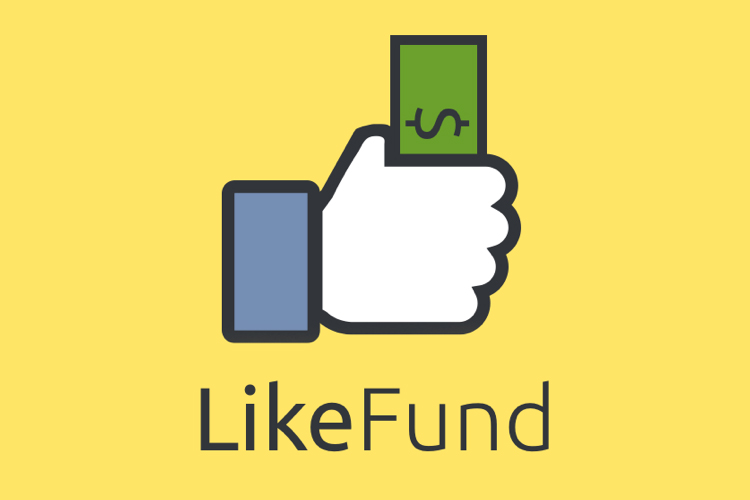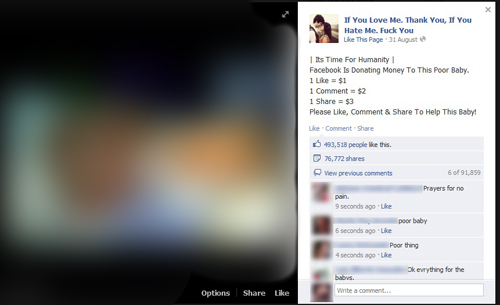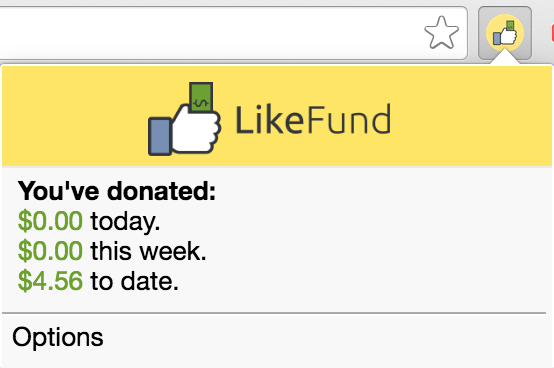LikeFund
 LikeFund logo
LikeFund logo
Motivation
“1 Like = $1 Donated to Charity.” Everyone has seen these viral posts on their newsfeeds with pictures of sick children or the aftermath of a natural disaster, and many of us are even guilty of believing that our social media efforts are capable of raising more than awareness. We’d all love to donate to a good cause, but few of us are willing to go out of our way to do so. Now with LikeFund, you don’t have to.
 An example of a Facebook post the promises donations for likes and comments, but ultimately does nothing. Explicit content blurred.
An example of a Facebook post the promises donations for likes and comments, but ultimately does nothing. Explicit content blurred.
Summary
LikeFund makes charity a part of your daily routine by putting charitable opportunities right in your newsfeed and sending the organization a microdonation of just a few cents from your checking account with each “Like”. These microdonations are so small that you won’t have to think twice before donating, but for a viral post with millions likes, they can add up to hundreds of thousands of dollars!
In recent years, it’s hard to find anyone who hasn’t seen something go viral on the internet. These instances can range from funny clips of animals to important information regarding the state of the world we live in. We’ve all seen the power of awareness - just knowing of the suffering around the world can change the way a person or a nation makes choices. In many cases, people may want to help but aren’t comfortable enough make a call and donate to charities even if they support a cause. We wanted to make it so that (useful) viral information does more than just make people aware, but also gives them an accessible way of providing tangible aid to people in need.
Technical Description
LikeFund is built as a Google Chrome extension for facebook.com. Users create an account through the extension where they can set their Donation per Like and link their bank account. For the purpose of this project, we used Capital One's Nessie API to mock bank accounts and transactions.
 LikeFund's overview page with payment history, detailed account stats, and monetized posts management.
LikeFund's overview page with payment history, detailed account stats, and monetized posts management.
Once set up, users can monetize any post by pressing a "Monetize" button and a "Donate" button will show up for all users. When other users press the "Donate" button, their Donation per Like is transferred to the poster's account and the post is liked by the user to help it go viral. These buttons are injected into the HTML with Javascript. The location for this HTML injection is detected by the "Like" button's class name.
 A monetized post that has been "Donated" to and "Liked".
A monetized post that has been "Donated" to and "Liked".
Users can keep track of LikeFund statistics right in the extension menu. Each donation/transaction is kept track of in a Firebase database, which keeps track of the amount, sender, receiver, Facebook post ID, and timestamp.
 LikeFund's extension menu with donation statistics.
LikeFund's extension menu with donation statistics.
What's Next?
LikeFund, although an idea I was very passionate about, was more a proof of concept rather than a consumer ready product. A Chrome extension needs to be installed by many users for it to be practical and it would be better if this feature were built into to Facebook itself. LikeFund showed that monetizing Facebook posts can be done, but requires more thought in areas such as fraud protection and spam protection.
Since building this Hackathon project, Facebook has introduced "Fundraisers" for charitable organizations, and I believe they are taking taking the proper steps to bring Fundraising to social platforms and making charity a part of people's daily routine.
Technology Used
HTML/CSS, Javascript, Capital One's Nessie API, Firebase